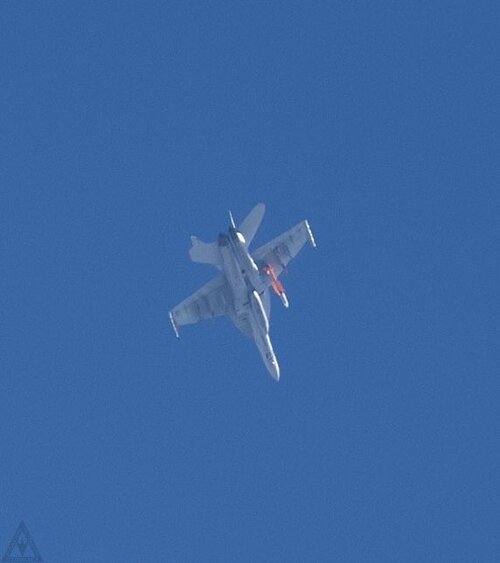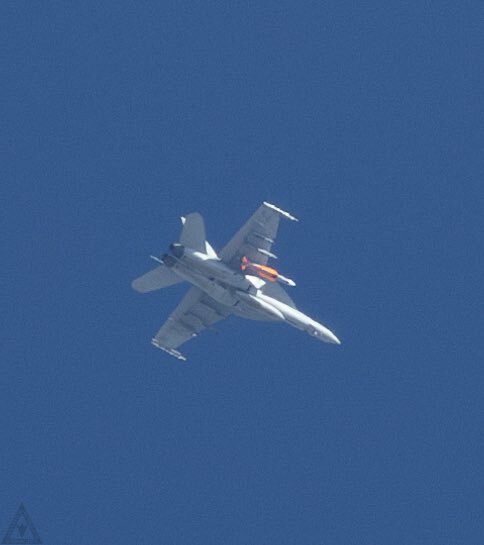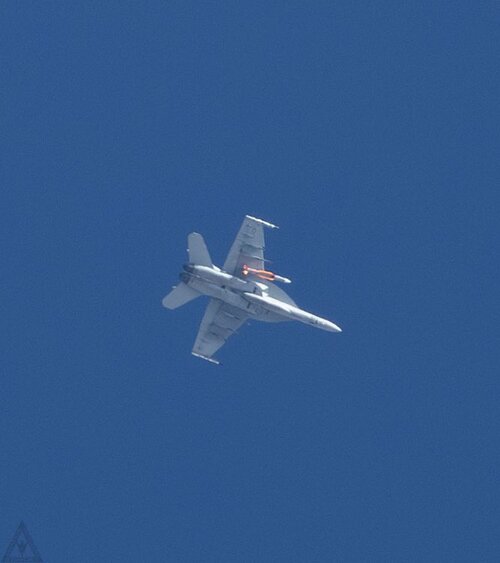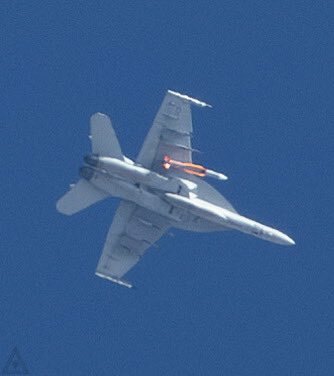Scott Kenny
ACCESS: Above Top Secret
- Joined
- 15 May 2023
- Messages
- 6,663
- Reaction score
- 5,682
It'd show up as soon as that nose cone hit atmosphere.Anyone ever hid a warhead in a nose-cone hoping to be ignored? For larger missiles.
It'd show up as soon as that nose cone hit atmosphere.Anyone ever hid a warhead in a nose-cone hoping to be ignored? For larger missiles.
“Hmmm that contact is on a trajectory towards our airbase should we intercept it?”Anyone ever hid a warhead in a nose-cone hoping to be ignored? For larger missiles.
with even smaller systems like Iskander deploying small rf decoys.
They wouldn’t but to my knowledge they’re also only for terminal stage though solely RF decoys could mess with cuing.RF penaids like those carried by the SS-26 Stone wouldn't against the SM-3's EKV as it uses a two-colour IIR seeker not an RF-seeker.
Those are far shorter range than the missiles Iran used in their attack. As such, if they ever do enter SM-3 engagement envelopes, cuing in time to hit them would be difficult.Something that occurred earlier today is that there's already been an opportunity for the USN to combat test the SM-3 Block-II and that's in the Red Sea intercepting ballistic missiles launched by Houthi terrorists.
You wouldn't waste an SM-3 on that sky trash.Something that occurred earlier today is that there's already been an opportunity for the USN to combat test the SM-3 Block-II and that's in the Red Sea intercepting ballistic missiles launched by Houthi terrorists.
Not Block IIA.It has been "bloodied" now if reports are correct.
Anyone ever hid a warhead in a nose-cone hoping to be ignored? For larger missiles.
Something that occurred earlier today is that there's already been an opportunity for the USN to combat test the SM-3 Block-II and that's in the Red Sea intercepting ballistic missiles launched by Houthi terrorists.
Those are probably too low of an altitude for SM-3 even if it was desirable.
Interview with Gerry Hueber, requirements and capabilities' vice president for the naval power business at Raytheon, during Sea Air Space 2024.
Hueber sheds light on the following topics:
01:29 - SM-6 including its latest at-sea test with the MDA
02:51 - ESSM Block 2
03:37 - Australia's Guided Weapons Explosive Ordnance Enterprise
04:45 - Challenges to ramping up missile production in the US
There has been a lingering concern regarding the inability to reload missiles in US warships at sea.Currently, the warships have to return to base for this purpose.
This issue has again come into focus with the US Navy’s recent operations in the Red Sea.Arleigh Burke-class destroyers had fired more than 100 Standard family surface-to-air missiles from Mk-41 cells at Houthi missiles and drones for interception.This clearly indicates that against a near-peer adversary like China, in a large-scale conflict, frontline American warships could run off of missiles very quickly.
In this video, Defense Updates analyzes why Congress is pushing the US Navy on ‘At-Sea’ rearmament ?
Chapters:
00:11 INTRODUCTION
01:42 Mk-41 VLS RELOAD
03:13 CONCERN RAISED
04:02 US NAVY’s EFFORTS
05:42 TRAM (Transportable Re-Arming Mechanism )
07:10 ANALYSIS
Lockheed Martin has test-fired a Patriot PAC-3 MSE interceptor from a Mk 70-series containerized launcher and used it to down a mock cruise missile. A modular and scalable version of the company's combat-proven Aegis Combat System called the Virtualized Aegis Weapon System, was used to execute the launch.This has the potential to be a game changer since this combination offers a valuable additional air and missile defense option for use in a slew of existing and future launchers, and not just on ships.
In this video, Defense Updates analyzes why the test-fire of an Patriot PAC-3 MSE interceptor from an Mk 70 launcher is a crucial development?
Chapters:
00:11 INTRODUCTION
01:41 LOCKHEED MARTIN INSIGHTS
02:48 PATRIOT PAC-3 MSE INTERCEPTOR
04:21 MK 70 PAYLOAD DELIVERY SYSTEM
05:30 VIRTUALIZED AEGIS WEAPON SYSTEM
06:50 ANALYSIS




Is there a location for the photo?
Was their two classified AAM projects? AIM-260 and something else?
How would we know if there were?
AIM-260 is at least out in the open enough we know about it.
I would be surprised if there was not some kind of very long range missile program for the USAF. It appears SM-6 might fill that role for the USN.
Yes, that's what I was thinking of:We do know that there is (or was) a separate Air Force program for a Long-Range Engagement Weapon, a long-range SAM that seems to be big enough to require external carriage on existing aircraft with internal weapon bays (F-22 and F-35) or the F-15. LREW was a Raytheon contract, so it's not impossible that it could be as mundane as an air-launched Active Standard, but the impression is that it's probably a new design.

Air-to-Air Missiles
AIM-260 Joint Advanced Tactical Missile (JATM). This radar-guided dogfight missile will be about the same size as the 30-year-old AIM-120 AMRAAM, but with considerably longer range. Built by Lockheed Martin it was first revealed in 2019. Little has been revealed since, but USAF has acknowledged that live tests were conducted in 2020 and 2021. The JATM’s enhanced range is greater than China’s PL-15—in many ways, an AMRAAM clone, restoring the “first shot, first kill” advantage to U.S. aircraft. The Navy and Army are said to be collaborating with USAF on JATM.
Long-Range Engagement Weapon (LREW). Another potential AMRAAM successor or JATM complement. Built by Raytheon, the LREW is reportedly a larger missile that can only be carried externally on fighters, and may be intended to shoot down adversary airborne warning systems, tankers, or bombers at great distances.
Could be a game changer against any high value airborne assets (multi engine AEW&C, tankers, etc). I would assume it could reach pretty far if launched from the airI had thought LREWxwas more of an experiment/study and that funding was closed out? But in any case I think it extremely likely that is some kind of program for a very long range missile optimized for multi engined targets.


It could also be a game changer against high value surface targets now that SM-6 does anti-surface warfare too. Possibly even as a hypersonic missile interceptor or a SEAD weapon. It seems to be an everything missile, or a JGTHA (Joint Go The Hell Away) missile.Could be a game changer against any high value airborne assets (multi engine AEW&C, tankers, etc). I would assume it could reach pretty far if launched from the air
That's easy, they have to work within budget caps at best and Continuing Resolutions when things get worse.One can only hope the USN peruses it. A number of commentators have been calling for this since before the first picture was released in 2021. It makes so much sense capability wise you almost have to wonder why this was not completed years ago.
That's easy, they have to work within budget caps at best and Continuing Resolutions when things get worse.
AFAIK SM-6 has not been exported (maybe Japan?).
The USN can hardly build enough SM-6 for itself.
I see DSCA cases for SK-6 sales to Japan and South Korea
What about Australia?
Newly surfaced photos reveal a U.S. Navy F/A-18E/F Super Hornet equipped with what looks like an air-launched variant of the highly versatile SM-6 missile. This combination of the Super Hornet and SM-6 was seen three years ago but has never been officially confirmed by the US Navy.This is an interesting development.
In this video, Defense Updates analyzes why the F/A-18E/F Super Hornet armed with SM-6 missile boon for the US Navy?
Chapters:
00:11 INTRODUCTION
01:35 SM-6 MISSILE
03:43 F/A-18E/F SUPER HORNET
05:25 US NAVY FACES THREAT
07:19 ANALYSIS
Given that massive increase in use by the USN *(Shooting down Houthi and Iranian missiles targeting shipping in the Red Sea and Israel) I can see Raytheon not only having to increase production capacity in its' existing Standard missile production line but having to open a second-source production line.
What about Australia?
*Also Ukraine's experience in the high-intensity Russo-Ukrainian war the current anti-air missile stocks are inadequate for such wars (It's increasingly likely that the PRC will attempt to invade Taiwan in the next few years and the USN will be pulled into it along the JSDF navy).
Not until we see the money.
